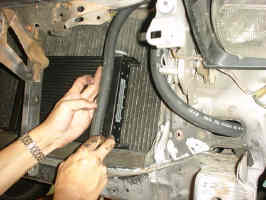AE86 4A-GE Oil Cooler Installation
Written by Slonie
Part 1: Shopping List
Before you begin, you'll need to get the required items. You'll need to decide on whether to a sandwich plate install (a pass-through plate that goes between the block and the oil filter) or a filter relocation setup (your oil filter is in-line with the lines going to the cooler). If you do relocation, you'll need two extra fittings.
1. Oil Cooler Core:
There are a wide variety of brands, sizes, and prices to choose from here. Some people go with a FC (2nd generation Mazda RX-7) factory oil cooler, which is very long and narrow. Others buy Earls, Setrab, or other brands available at local shops.
In this install, we used a Setrab cooler. The core is 7.5" x 13" and 25 rows. Setrab produces very nice units. They ship with adaptor fittings so that you can select which size line you want to run. 8AN or 10AN is good for this application. I used 10.
 2. Sandwich Plate or Block Adaptor and filter relocation block:
2. Sandwich Plate or Block Adaptor and filter relocation block:
This is an area where you can spend more money to gain convenience and cleanliness. A sandwich plate will get allow you to get the cooler in a positive flow setup with the least amount of work and money. That's what we used in this installation.
However, a oil filter relocation setup has a few benefits. First of all, the oil filter can be positioned anywhere you want, reducing clutter in the engine bay and allowing easy filter changes. Another benefit of relocating the filter is the ability to position the filter BEFORE the cooler so that oil coming out of the block passes through the filter before passing through
the cooler. In the long run, this will keep junk out of your cooler.
CAUTION: A filter relocation setup incurs the risk of running the oil lines
backwards through the filter. Doing this will cause a serious drop in oil
pressure and risk of blowing your motor. Oil filters take oil in through the
outer ring, and pass filtered oil back to the block through the center
threaded section. As such, care must be taken when hooking up the oil lines
to a filter relocation block.
 3. Hose End Fittings:
3. Hose End Fittings:
Once again, there are many choices of fittings to get, and the choice here will be paired with the appropriate hose. For this install, we used Aeroquip Socketless hose and fittings. These press-on fittings are relatively cheap, while still boasting 250psi pressure and 300F temperature ratings. This would be a good time to figure out how you're going to mount your cooler. Knowing this in advance will help you buy the most convenient fittings for your installation. In our case, the cooler could have been mounted right-side up without stressing the hoses if 90-degree fittings had been used instead of straight ones. Plan ahead!
 4. Hose and Clamps:
4. Hose and Clamps:
The kind of hose you buy will be intertwined with the fitting type. Aeroquip Socketless Hose is designed for use with their fittings exclusively, so that's what was used here. Though fancy and expensive, one need not always use steel braided lines for a normal 4A-GE as pressures from stock pump isn't nearly enough to shear a high-grade rubber hose made for oil lines.
Where to Buy:
Earl's Performance
Baker Precision Products
Part 2: Installing the cooler
This article will go over the install of the Setrab cooler using a sandwich plate configuration. Baker Precision Products in Long Beach, CA recommended the use of Aeroquip Socketless fittings and hose as a high-quality yet budget-minded solution.


First, drain your oil and remove the filter. Apply teflon tape to fitting adaptors and screw them into the sandwich plate. Then use grease or oil on the O-ring side of the sandwich plate and place it on the block where the oil filter would normally go. Attach the plate to the block by tightening the center nut. Sometimes, the tape isn't necessary on high-grade aluminum fittings but it never does any harm either so when in doubt, use it... The adaptor plate used in this installation was a Perma-Cool #181 Sandwich Adaptor (3/8" FPT ports and 3/4" -16 thread).


Next, the location of the cooler was decided in order to determine how short the lines would have to be cut to. Our choice was to zip-tie the cooler directly to the radiator. While it sounds more backward than the OEM-style mounting location, it gets results. The reasons behind it are twofold.
First, air has no path to escape around the oil cooler. If it's hitting the face of the radiator, it must go through the oil cooler. Second, there is a heat exchange effect between the oil cooler and radiator. This takes advantage of the fact that water temps are rarely as much of a problem as oil temps on the 4A-GE during track driving.
Because of the straight across fittings that we already had, it was necessary to position the cooler at a 90-degree angle itself to avoid stressing the hoses too much. The hoses have a maximum degree to which they can bend without kinking, and you don't want to exceed that. Once again, selection of which side of the cooler to select as IN and which as OUT is
important if the ports are at the top and bottom like in this arrangement. We'd prefer to be pumping oil into the bottom of the cooler and out on the top, in order to evacuate air that may be trapped inside the cooler. Keep this in mind if a your mounting arrangement necessitates it.


With the location chosen for the cooler, we took the lines and ran them along the intended path from the sandwich plate to the cooler. We marked the lines with the approximate required length. With this in mind, it was time to attach the fittings to the hose. Assembling these socket-less fittings is a simple process. First, cut the hose with a razor blade so that it provides a flat end. Then, lubricate the fitting and the hose with oil and press the hose onto the fitting. With straight across fittings, it was easy to just push the hose down to the ground with the fitting standing straight up. However, for 90-degree and other fittings you may find it easiest to use a vise to hold the fitting while you push the hose onto it. Slow and steady
pressure is the way to go. The fitting is on once the hose reaches the end "cap" of the fitting and is more or less seated on it. If you have trouble getting the fitting on, a hair dryer or heat gun may help.
With the fittings onto the hose, you can screw them into place. For extra security on the threads, we used more Teflon tape.
Once everything is in place, double check that you have all the lines hooked up correctly (especially if using a filter relocator. TRIPLE-check that the oil will come out of the block, and into the channel that leads to the OUTSIDE ring of the oil filter...This is the way to make sure it's flowing in the correct direction)
Fan concerns: It's a good idea to locate the cooler in such way as to get very positive airflow both standing still and when the car is in motion. If cooler core is away from the radiator surface, it's pertinent to have channeled airflow and baffles to keep air from going around the small but thick cooler core surface.
Put the drain plug back in, put a new filter on, and you're done. Oh yes, you might want to add some oil before starting up the first time!
To keep the engine from over-revving on lubrication starved conditions after a new installation, it's a good idea to remove spark plugs and crank the engine for a few seconds until you see stable oil pressures. Replace the spark plug wires to check pressure under idle, then at higher rpm. Just check that everything is normal once again.
After installing the large Setrab unit with a somewhat excessive length of hose (to allow for future easy relocation block installation), the motor took about 1-1.5 quarts extra of oil.


Results:
The result of this installation was a significantly lowered oil temperature during normal operation as well as autocross and open track lapping and drifting. Autocross oil temps were lowered from 100C to 90C, and track temps were lowered from a peak of 120C to 105C. Ironically, freeway temperatures sit at a cool 60C rather than the 80C usually considered "operating temperature".
In cooler climates or seasons, one may need to cover the cooler up in order to attain proper operating temperature. One solution to this is the availability of thermostatically controlled sandwich plates that only open up the path to the oil cooler once oil has reached 82C. This is a good idea for colder climates, but I have not tried this myself and make no claims to the reliability of such a system. Or alternatively, simply cut a piece of a cardboard or plastic panel and tape it to the core to reduce the cooling effect. This will keep mud and grime in muddy snowmelt conditions from piling up inside the core fins.


